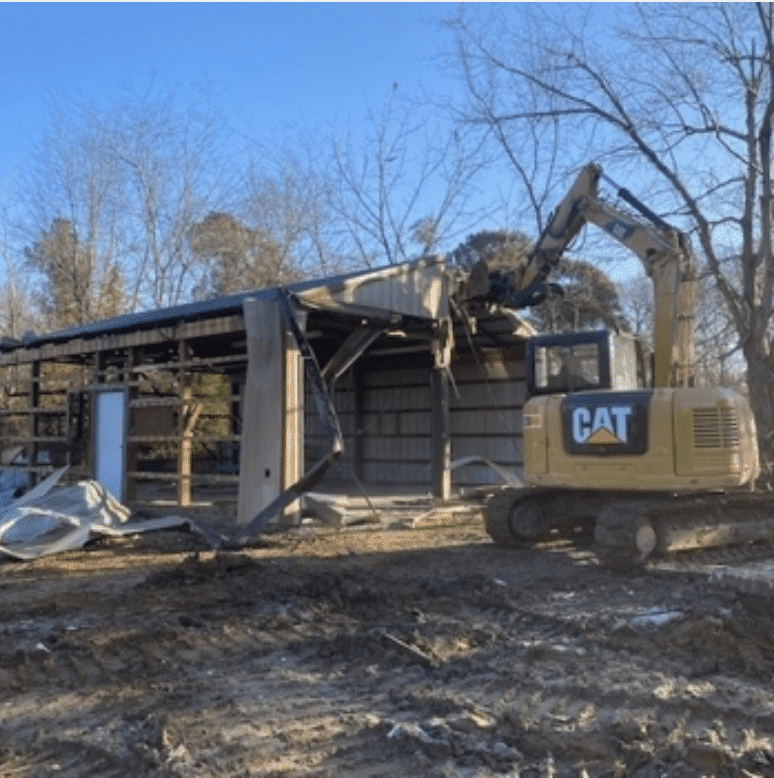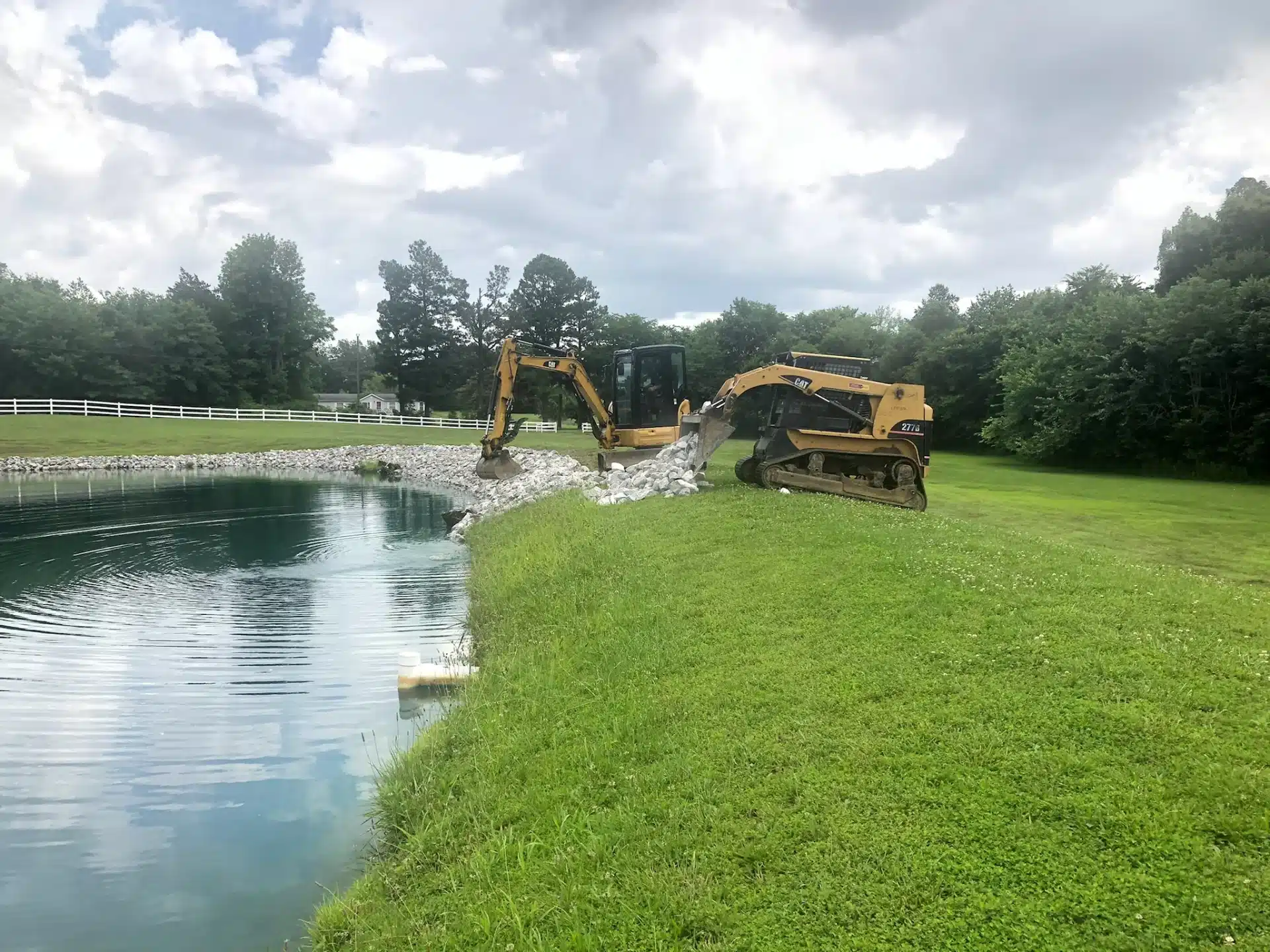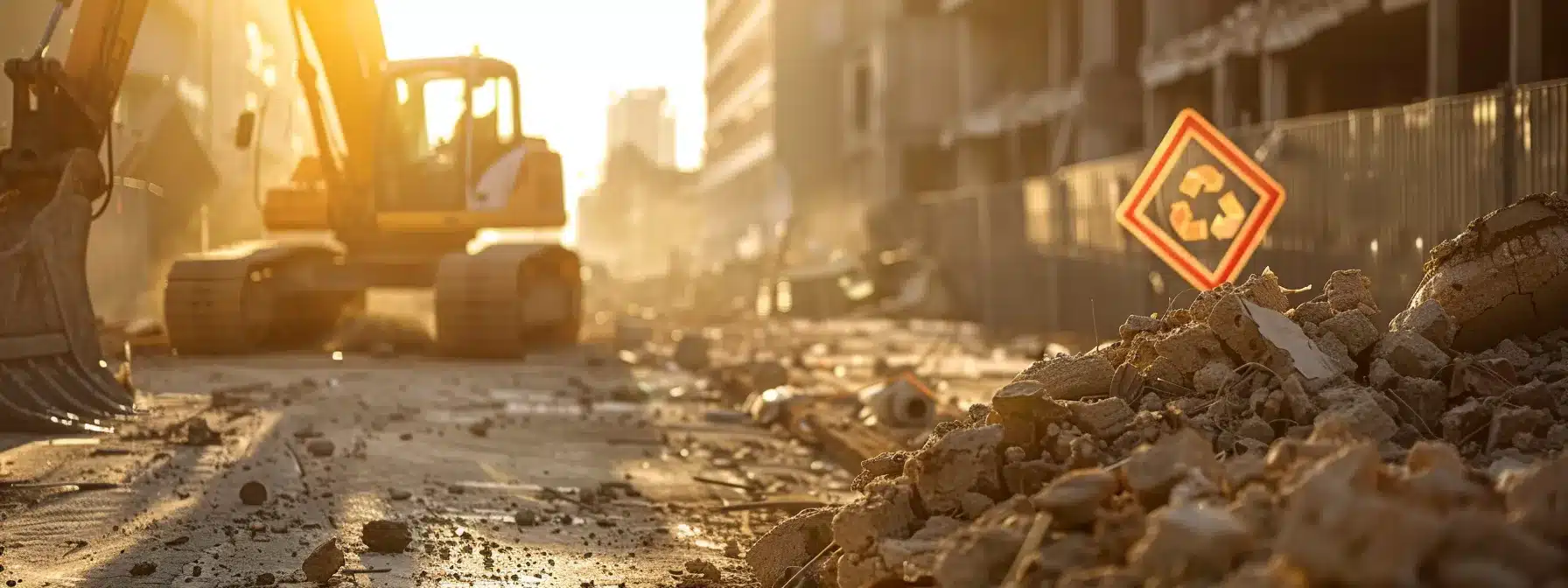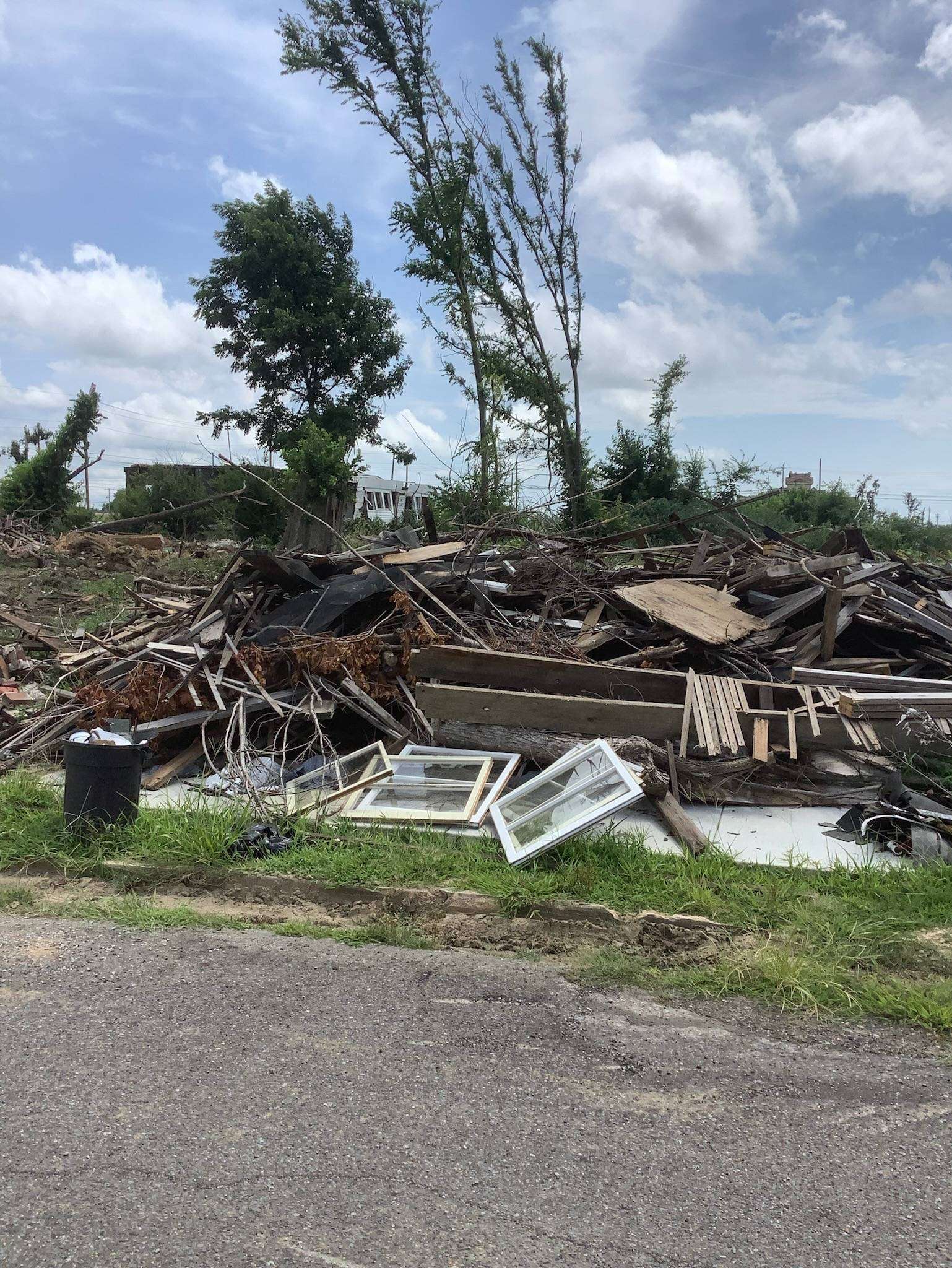Are you struggling with soil erosion on your property? Riprap is a powerful solution for stabilizing soil and preventing erosion. This article will explain how riprap works, guide you in selecting the right materials, and provide tips for proper installation and maintenance. By understanding the mechanisms behind riprap’s effectiveness in sediment control and filtration, you’ll be equipped to protect your land from erosion. We’ll also explore real-world examples of riprap in action, demonstrating its ability to safeguard everything from simple trenches to large-scale projects involving topsoil and compost.
Key Takeaways
- Riprap effectively protects against soil erosion by absorbing wave energy and stabilizing the ground
- Proper riprap installation involves site preparation, appropriate material selection, and regular maintenance
- Riprap redirects water flow, absorbs energy, and enhances soil strength to prevent erosion
- Successful riprap projects have protected coastlines, stabilized riverbanks, and improved urban drainage systems
- Regular inspections and preventive measures are crucial for maintaining riprap’s effectiveness over time
Understanding Riprap and Its Role in Erosion Control
Riprap, a versatile erosion control method, offers effective protection for slopes and shorelines. You’ll learn how this technique works, including its use in check dams and as an armour layer. Discover scenarios where riprap excels, such as stabilizing steep slopes and reinforcing silt fences. Understand how riprap’s interlocking stones and optional grout create a robust barrier against soil erosion.
Defining Riprap and Its Purpose
Riprap is a technique used in coastal management and erosion control, consisting of strategically placed rocks or other materials along shorelines or slopes. You’ll find that this method effectively protects against soil erosion by absorbing wave energy and stabilizing the ground, particularly in areas prone to water flow or wave action.
The purpose of riprap extends beyond simple erosion prevention. It also creates habitat for fish and other aquatic life, maintains sand permeability, and can be used in combination with other erosion control methods like xbloc. By understanding riprap’s versatility, you can make informed decisions about its application in your erosion control projects.
Common Scenarios Where Riprap Is Effective
You’ll find riprap particularly effective in areas where water flow or wave action poses a significant threat to soil stability. This method excels in stabilizing steep slopes, protecting shorelines, and reinforcing areas around bridges or culverts. Riprap can also complement other erosion control techniques, such as sod installation or textile groundcover, providing a robust solution for your yard or landscaping projects.
In scenarios where traditional erosion control methods fall short, riprap offers a durable alternative. It’s especially useful in high-energy environments where soil erosion is accelerated, such as along riverbanks or coastal areas. By combining riprap with fiber-based erosion control products, you can create a comprehensive system that protects against both surface and subsurface erosion, ensuring long-term stability for your property.
How Riprap Protects Soil From Erosion
Riprap protects soil from erosion by creating a sturdy barrier against wave action and water flow. You’ll find that the interlocking stones dissipate energy, reducing stress on the underlying soil. This protective layer also improves drainage, preventing water from accumulating and weakening the soil structure.
When you install riprap, it forms a natural wall that shields vulnerable areas from erosion. The spaces between rocks allow for tree root growth, further stabilizing the soil. This combination of physical protection and enhanced vegetation creates a robust defense against erosive forces:
| Riprap Feature | Erosion Control Benefit |
|---|---|
| Interlocking stones | Dissipates wave energy |
| Improved drainage | Prevents soil weakening |
| Natural wall formation | Shields vulnerable areas |
| Spaces between rocks | Allows tree root growth |
The Mechanisms Behind Riprap Stabilizing Soil
Riprap stabilizes soil through three key mechanisms. You’ll learn how it redirects water flow, absorbs energy from waves and runoff, and enhances soil strength. These processes work together to protect your landscape from erosion, prevent gully formation, and create a strong foundation for water discharge management.
Redirecting Water Flow to Prevent Erosion
Riprap effectively redirects water flow, preventing erosion by guiding runoff away from vulnerable soil areas. You’ll find that strategically placed limestone or granite rocks create channels that divert water, reducing its erosive impact on the underlying soil. This redirection helps maintain soil integrity and prevents the formation of gullies or deep channels.
When you install riprap, it establishes a protective barrier that slows water velocity and disperses its energy. This process not only prevents soil erosion but also helps mitigate eutrophication in nearby water bodies by reducing sediment transport. Additionally, the spaces between riprap stones allow for root growth, further stabilizing the soil structure:
- Channels water away from vulnerable areas
- Reduces water velocity and erosive force
- Prevents gully formation
- Allows for beneficial root growth
- Mitigates eutrophication in nearby water bodies
Absorbing and Dissipating Energy From Waves and Runoff
Riprap effectively absorbs and dissipates energy from waves and surface runoff, protecting your soil from erosion. When you install riprap, it creates a rough surface that breaks up the flow of water, reducing its velocity and erosive power. This process is particularly effective in managing stormwater, as the riprap slows down the water, allowing it to infiltrate the soil more gradually.
To enhance the effectiveness of riprap, you can incorporate geotextile fabrics beneath the stones. This combination provides additional protection against erosion and helps stabilize the underlying soil. For areas with high-energy water flow, such as levees or steep slopes, you might consider using concrete riprap for increased durability and erosion resistance. The key benefits of riprap in absorbing and dissipating energy include:
- Breaks up water flow, reducing velocity
- Facilitates gradual water infiltration
- Works well with geotextile fabrics for added protection
- Can be enhanced with concrete for high-energy areas
- Effectively manages stormwater runoff
Enhancing Soil Strength Through Riprap Installation
When you install riprap, it significantly enhances soil strength by creating a protective layer that shields against erosion from rain and storms. This technique, often used in coastal engineering, distributes the weight of water and soil pressure evenly, acting like a natural retaining wall. The interlocking stones of riprap provide stability to steep slopes and shorelines, preventing soil loss and maintaining the integrity of your landscape.
Riprap installation also promotes vegetation growth between the stones, further strengthening the soil structure. As plants establish their root systems, they intertwine with the riprap, creating a robust network that resists erosion. This combination of riprap and vegetation offers superior protection against the forces of nature, ensuring long-term soil stability even in harsh coastal environments or areas prone to heavy rainfall and storms.
Selecting the Right Riprap Materials for Your Project
Selecting the right riprap materials is crucial for effective erosion control and soil stabilization. You’ll learn about different types of riprap stones and their uses, factors to consider when choosing riprap size, and environmental considerations in material selection. Understanding these aspects helps you create an energy-efficient, environmentally friendly solution for your ditch or slope protection project.
Different Types of Riprap Stones and Their Uses
When selecting riprap for your project, you’ll encounter various types of stones, each suited for different applications. Granite and limestone are popular choices for their durability and resistance to weathering, making them ideal for protecting infrastructure against high-velocity water flow and ice damage. These materials excel in storm drain reinforcement and soil erosion prevention, especially in areas prone to severe weather conditions.
For coastal projects or areas with aggressive water action, you might consider using quarried rock or concrete rubble. These materials offer excellent stability and can withstand the constant battering of waves, helping to reduce soil erosion along shorelines. When dealing with steep slopes or areas with rapid runoff, angular riprap stones provide better interlocking capabilities, enhancing the overall stability of your erosion control system.
Factors to Consider When Choosing Riprap Size
When choosing riprap size for your project, you need to consider the specific erosion forces at play. For rivers and ponds, larger stones are often necessary to withstand the constant water flow and prevent sediment transport. In areas with clay soil, you might opt for smaller riprap sizes to ensure proper interlocking and stability.
The slope of your project area also influences riprap size selection. Steeper slopes, such as those reinforced with soil nailing techniques, typically require larger stones to maintain stability. Additionally, consider the potential for ice formation in colder climates, as this may necessitate larger riprap to resist ice damage and maintain erosion control effectiveness.
Environmental Considerations in Material Selection
When selecting riprap materials for your erosion control project, consider the environmental impact. Choose locally sourced riprap rock to reduce transportation emissions and support your community’s economy. Gabion structures filled with natural stones can provide effective erosion control while blending seamlessly with the surrounding landscape, minimizing disruption to local wildlife habitats.
Consider using recycled materials for your riprap installation to promote sustainability. Concrete rubble from demolished structures can be repurposed as effective riprap, reducing waste and conserving natural resources. When installing riprap near water bodies, ensure the materials are free from contaminants to protect aquatic ecosystems and maintain water quality. Your environmentally conscious choices in riprap selection contribute to both effective erosion control and ecological preservation:
- Use locally sourced materials to reduce carbon footprint
- Incorporate recycled materials when possible
- Choose non-toxic options for aquatic environments
- Consider wildlife-friendly designs
- Opt for natural stone to blend with the landscape
Installing Riprap for Optimal Soil Stabilization
Installing riprap effectively is crucial for optimal soil stabilization and erosion prevention in streams and ecosystems. You’ll learn how to prepare the site, follow a step-by-step guide for laying riprap, avoid common mistakes, and implement safety tips. This process ensures proper sediment transport control and energy dissipation, reducing silt buildup and protecting your landscape.
Preparing the Site for Riprap Installation
Before installing riprap, you must conduct a thorough inspection of the site. This includes assessing the slope, soil type, and water flow patterns along the coast, dam, or road where you plan to install the riprap. Proper site preparation ensures the rock will effectively stabilize the soil and prevent erosion.
You’ll need to clear the area of debris and vegetation, then grade the slope to the desired angle. For coastal projects, consider the high-water mark and wave action when determining the extent of your riprap installation. If you’re working on a dam or near a road, pay special attention to drainage patterns to ensure the riprap effectively channels water away from vulnerable areas.
Step-by-Step Guide to Laying Riprap
To begin laying riprap, you’ll need to excavate a trench along the slope’s base, creating a solid foundation for the stones. Next, install a layer of gravel or geotextile fabric to improve drainage and prevent soil erosion beneath the riprap. As you place the stones, start from the bottom and work your way up, ensuring each piece interlocks with its neighbors for maximum stability.
For larger projects, such as those along the Mississippi River, consult an engineer to determine the appropriate stone size and placement technique. After laying the riprap, you can plant native seeds or seedlings in the gaps between stones to enhance soil stabilization and create a more natural appearance. This combination of riprap and vegetation provides superior erosion control and habitat restoration.
Common Mistakes to Avoid During Installation
When installing riprap, avoid using uniformly sized concrete blocks, as this can lead to inadequate interlocking and reduced shear stress resistance. Instead, opt for a mix of shapes and sizes to create a more stable structure that effectively dissipates energy from water flow. Be cautious not to overlook the importance of proper site preparation, including addressing any existing pollutants that may compromise the riprap’s effectiveness.
Another common mistake is neglecting to account for the specific conditions of your project site, such as the slope angle or the water level fluctuations in a lake. Failing to properly assess these factors can result in undersized riprap that’s unable to withstand the forces acting upon it. To ensure optimal soil stabilization, consider the following key points:
- Use a variety of stone shapes and sizes
- Prepare the site thoroughly, removing pollutants
- Assess site-specific conditions (slope, water levels)
- Choose appropriate riprap size for the project
- Ensure proper interlocking of stones
Safety Tips for Effective Riprap Placement
When placing riprap, prioritize safety by wearing appropriate personal protective equipment, including hard hats and steel-toed boots. This is especially important during bridge construction or when working near channels, where falling rocks pose a significant hazard. Ensure proper footing and use safety harnesses when working on steep slopes to prevent accidents and potential landslides.
Before beginning riprap placement, conduct a thorough site assessment to identify any potential nutrient runoff issues or unstable soil conditions. This step is crucial for effective erosion control and helps prevent environmental damage during construction. When working near water bodies, use silt fences or other sediment control measures to minimize the impact on aquatic ecosystems and maintain water quality.
Maintenance Practices to Prolong Riprap Effectiveness
Regular maintenance is crucial for prolonging riprap effectiveness in stabilizing soil and preventing erosion. You’ll learn about inspection procedures, addressing damage over time, and preventive measures to enhance longevity. These practices help maintain riprap’s role in combating coastal erosion and preserving habitats. By incorporating techniques like mulching and anchoring, you’ll ensure your riprap continues to protect organic matter and soil structure effectively.
Regular Inspection Procedures
To maintain the effectiveness of your riprap installation, conduct regular inspections, especially after flood events or severe weather. Check the riparian zone for signs of erosion or displacement of stones, paying close attention to areas around culverts and breakwaters. Look for gaps in the riprap coverage that could compromise its ability to protect against soil erosion.
During your inspection, assess the stability of larger rubble pieces and ensure they haven’t shifted due to water pressure or ice formation. Examine the edges of your riprap installation where it meets natural terrain, as these areas are often more susceptible to erosion. Keep a detailed record of your inspections to track changes over time and identify potential problem areas early:
| Inspection Area | What to Look For | Action Required |
|---|---|---|
| Riparian Zone | Erosion signs, displaced stones | Reposition stones, add new riprap if needed |
| Culverts | Undermining, water bypass | Reinforce riprap around culvert edges |
| Breakwaters | Structural integrity, wave damage | Replace damaged stones, reinforce structure |
| Rubble Stability | Shifting of large pieces | Reposition and secure large stones |
| Riprap Edges | Gaps, erosion at boundaries | Extend riprap coverage, add soil stabilizers |
Addressing Damage and Wear Over Time
As your riprap ages, you may notice signs of wear and damage that can compromise its effectiveness in preventing erosion and water pollution. Inspect your riprap regularly for displaced stones, gaps in coverage, or areas where soil has washed away beneath the rocks. Address these issues promptly by repositioning loose stones and adding new riprap to fill gaps, ensuring continuous protection against soil erosion and runoff.
To combat water pollution and maintain riprap integrity, remove any accumulated debris or sediment that could impede proper drainage. You can also consider adding a layer of filter fabric beneath damaged areas when repairing your riprap. This extra step helps prevent soil loss and reduces the risk of contaminants entering nearby water sources, preserving both your property and local water quality.
Enhancing Longevity Through Preventive Measures
To enhance the longevity of your riprap installation, implement preventive measures such as installing proper drainage systems. Ensure water flows away from the riprap area by creating swales or French drains, reducing the risk of erosion and undermining. You can also apply soil stabilizers or plant vegetation between riprap stones to create a more robust erosion control system.
Consider using geotextile fabrics beneath your riprap to prevent soil migration and maintain structural integrity. Regularly trim nearby vegetation to prevent root systems from displacing stones, and monitor water flow patterns to anticipate potential erosion issues before they become severe. By taking these proactive steps, you’ll significantly extend the lifespan and effectiveness of your riprap installation.
Real-World Examples of Riprap Preventing Erosion
Explore real-world examples of riprap’s effectiveness in preventing erosion across diverse environments. You’ll discover successful coastal projects, learn how riprap stabilizes riverbanks, and see its applications in urban drainage systems. These cases demonstrate riprap’s versatility and reliability in soil stabilization and erosion control.
Successful Riprap Projects in Coastal Areas
You’ll find impressive examples of successful riprap projects in coastal areas along the Gulf Coast. After Hurricane Katrina, Louisiana implemented extensive riprap installations to protect shorelines and prevent further erosion. These projects have significantly reduced storm surge damage and stabilized vulnerable coastal areas, demonstrating the effectiveness of riprap in high-energy marine environments.
In Florida, you can observe how riprap has been used to protect coastal highways from erosion. The A1A coastal highway project in Flagler Beach showcases how strategically placed riprap can safeguard critical infrastructure while maintaining beach access. This project has successfully mitigated erosion caused by severe storms and sea-level rise, ensuring the longevity of both the highway and the surrounding coastal ecosystem.
Riverbank Stabilization Using Riprap
You’ll find impressive riverbank stabilization projects using riprap along the Mississippi River. The U.S. Army Corps of Engineers has implemented extensive riprap installations to protect vulnerable sections of the riverbank from erosion. These projects have successfully prevented soil loss and maintained the river’s navigability, demonstrating riprap’s effectiveness in high-flow environments.
In urban areas, you can observe how riprap stabilizes riverbanks while preserving natural habitats. The Anacostia River Restoration Project in Washington, D.C., showcases how strategically placed riprap can protect shorelines and support ecosystem recovery. This project has effectively reduced erosion, improved water quality, and enhanced wildlife habitats along the river, highlighting riprap’s versatility in urban river restoration:
- Protects vulnerable riverbank sections
- Prevents soil loss in high-flow environments
- Maintains river navigability
- Supports ecosystem recovery in urban areas
- Improves water quality and enhances wildlife habitats
Riprap Applications in Urban Drainage Systems
In urban areas, you’ll find riprap effectively managing stormwater runoff in drainage systems. Cities like Portland, Oregon, have implemented riprap-lined channels to control erosion and reduce sediment transport in their green infrastructure projects. These installations have significantly improved water quality and reduced the risk of flooding by slowing water flow and promoting infiltration.
You can observe riprap’s effectiveness in urban settings at the Minnehaha Creek Watershed District in Minnesota. Here, riprap has been used to stabilize stream banks and protect infrastructure from erosion caused by heavy rainfall events. This application demonstrates how riprap can be integrated into urban landscapes to enhance both functionality and aesthetics, providing a sustainable solution for managing urban water resources.
Contact Supreme Enterprises for Erosion Control Services
When looking for a reliable and experienced provider of erosion control services, contacting Supreme Enterprises is your best bet. With years of experience and a proven track record in the industry, Supreme Enterprises offers top-notch solutions to prevent soil erosion and protect your property from damage. Our team of experts is well-versed in various erosion control techniques and can tailor their services to meet your specific needs.
By choosing Supreme Enterprises for your erosion control needs, you can rest assured that you are getting quality service delivered with professionalism and expertise. From erosion control blankets to silt fences and hydroseeding, we have the tools and knowledge to effectively manage erosion on your property. Whether you are a homeowner, land developer, or construction company, Supreme Enterprises can help mitigate erosion issues and ensure the long-term stability of your land.
Don’t wait until erosion becomes a major problem on your property. Contact Us today to discuss your erosion control needs and receive a customized solution that fits your requirements. Trust in our team’s expertise and professionalism to protect your property and preserve the natural beauty of your land for years to come.













